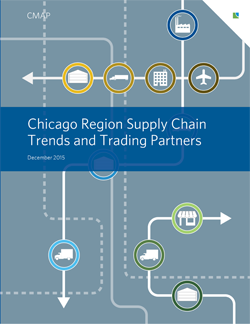Metropolitan Chicago serves as one of the nation's primary hubs for the movement of goods on a local, national, and international scale, with an estimated $1.3 trillion in goods moving into and out of the region each year. The region's diverse industries traded roughly $365 billion in goods with domestic partners and $245 billion in goods internationally. ON TO 2050 underscores the importance of investing in infrastructure in a way that supports our region's industries, in part by understanding the characteristics of their trade activities. In today's economy, freight movements include the shipment of goods over longer distances, via multiple modes, and at higher frequencies. Investments in transportation infrastructure can help grow the regional economy by modernizing and prioritizing multimodal freight facilities that enhances the region's global competitiveness.
CMAP's 2017 Metals Supply Chain (PDF) report examines the Chicago region’s metals manufacturing cluster in depth, focusing on the flow of commodities and final goods between related industries. It characterizes key relationships within the metals manufacturing cluster, how these relationships create a regional supply chain, and how trends in employment and global competition are influencing the cluster. The report offers a number of recommendations for supporting the future growth of this cluster.
CMAP’s industry analysis builds on the 2015 report Chicago Region Supply Chain Trends and Trading Partners (PDF), which assesses the flow of goods into and out of the region. The report analyzes the flow of various commodities by freight mode, origin, and destination, while identifying the region's major trading partners. It also explores the decisions that drive logistics choices in the region's manufacturing clusters, and identifies current and future challenges for supporting the changing nature of goods movement.

